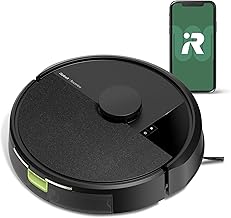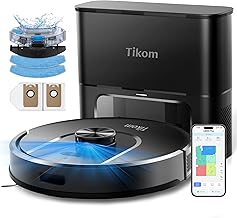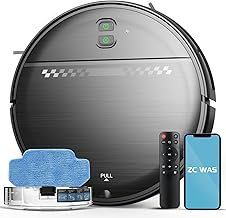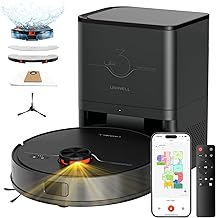A Smart Robot Vacuum is an autonomous, disc-shaped appliance that uses a combination of sensors, software, and powerful suction to clean floors without human intervention. Evolving from simple, random-bump cleaning machines, modern smart robot vacuums are sophisticated devices that can map your home, be scheduled or controlled remotely, and integrate into a broader smart home ecosystem.
Core Functionality: How It Works
The operation of a smart robot vacuum can be broken down into three key areas: Navigation, Cleaning, and Connectivity.
Navigation and Mapping (The "Brain")
This is what separates basic models from smart ones. The navigation system determines how efficiently the vacuum covers your floor.
Sensors:
Cliff Sensors: Infrared sensors on the underside detect ledges and stairs, preventing the vacuum from falling.
Bump Sensors: Physical sensors (or infrared) detect obstacles like furniture legs and walls, triggering a direction change.
Wall Sensors: Specialized sensors help the vacuum detect and follow walls for edge cleaning.
Wheel Encoders: Track the rotation of the wheels to estimate distance traveled.
Mapping Technologies:
LiDAR (Light Detection and Ranging): A laser sensor on top of the vacuum rotates 360 degrees, measuring the distance to objects to create a highly precise, real-time map of the home. This is considered the gold standard for navigation.
vSLAM (visual Simultaneous Localization and Mapping): Uses an upward-facing camera to track visual landmarks on the ceiling and features in the room to create and orient its map.
Gyroscopic Navigation: Uses an internal gyroscope and accelerometer to track its movement and direction, creating a less precise "path" rather than a true map.
- Cleaning System (The "Brawn")
This is the physical mechanism that picks up dirt, dust, and debris. Suction Motor: Generates the airflow that pulls in dirt. Power is measured in Pascals (Pa); higher Pa generally means stronger suction.
Main Brush (Roller): A rotating brush, often bristle-and-rubber combos, that agitates carpet fibers and sweeps debris from hard floors into the vacuum's path.
Side Brushes: One or two extendable brushes on the side that sweep debris from corners and along edges toward the main suction inlet.
Filtration System: A series of filters, typically including a high-efficiency particulate air (HEPA) filter, that traps allergens and fine dust, preventing them from being recirculated into the air.
Dustbin: A removable container that collects the sucked-up debris. Capacity varies by model.
Connectivity and Smart Features (The "Control")
This layer allows for remote control, automation, and integration.
Wi-Fi Connectivity: The core of its "smart" capabilities, allowing connection to your home network.
Companion Mobile App: Allows users to start/stop cleaning, view the robot's map, set cleaning schedules, view cleaning history, and receive notifications.
Voice Control: Integration with smart assistants like Amazon Alexa, Google Assistant, and sometimes Apple Siri allows for voice commands (e.g., "Alexa, ask Roomba to start cleaning").
Smart Mapping Features:
No-Go Zones / Keep-Out Zones: Virtual boundaries you draw on the map to prevent the vacuum from entering specific areas (e.g., a pet water bowl area or a room with loose cables).
Selective Room Cleaning: The ability to command the vacuum to clean only specific rooms from the app.
Multi-Floor Mapping: The ability to save multiple maps for different levels of a home, recognizing which floor it's on and applying the correct map.
Advanced Features and Evolution
Self-Emptying Docks: The robot automatically returns to its dock, which empties the dustbin into a larger, sealed bag inside the station. This can allow for weeks of hands-free cleaning.
Auto-Mopping: Some models feature a water tank and mopping pad that can scrub hard floors. Advanced models can automatically dispense water and even lift the mop pad when transitioning to carpets.
AI and Object Recognition: Using camera-based AI, the latest models can identify specific objects (like shoes, cords, or pet waste) and avoid them, rather than just bumping into them.
Automatic Dirt Disposal: Integrated with the self-emptying dock, the station itself holds weeks or months of dirt, which is then disposed of in one go.
Advantages of Using a Smart Robot Vacuum
Convenience and Time-Saving: The primary benefit. It cleans automatically on a schedule, freeing up your time.
Consistent Maintenance: Daily or weekly scheduled cleaning prevents dirt and dust from accumulating, maintaining a consistently cleaner floor.
Improved Air Quality: HEPA filtration traps allergens like pollen, pet dander, and dust mites, benefiting those with allergies or asthma.
Accessibility: A boon for the elderly, people with mobility issues, or those with busy schedules who struggle to find time for regular vacuuming.
Reach Under Furniture: Its low profile allows it to clean under beds, sofas, and other furniture where traditional vacuums can't reach.
Limitations and Considerations
Initial Cost: High-end smart robot vacuums with mapping and self-emptying features are a significant investment.
Maintenance: Requires regular upkeep: emptying the dustbin, cleaning brushes (especially hair tangles), and replacing filters and side brushes periodically.
Not a Complete Replacement: It is designed for maintenance cleaning, not deep cleaning. It may struggle with large debris, ground-in dirt, or very high-pile carpets.
Navigation Challenges: It can get stuck on dark-colored carpets, thick rugs, or cords. Cluttered floors can impede its efficiency.
Limited Mopping Capability: For most models, mopping is a light scrubbing function and is not comparable to a traditional wet mop for tackling stuck-on spills.
Key Selection Criteria
When choosing a smart robot vacuum, consider:
Floor Type: Do you have mostly carpets (needs strong suction and a roller brush) or hard floors (needs good edge cleaning)?
Home Layout: Complex, multi-room homes benefit greatly from LiDAR mapping. For simple studio apartments, a simpler model may suffice.
Pets: Pet owners need strong suction, a tangle-free roller brush, and excellent filtration. Object recognition to avoid pet waste is a critical feature.
Smart Features: Decide if you need features like selective room cleaning, no-go zones, and voice control.
Budget: Balance the cost against the desired features, from basic navigation to fully automated self-emptying systems.
The Smart Robot Vacuum has evolved from a novelty to a core appliance in the modern smart home. By combining advanced navigation, effective cleaning mechanics, and seamless connectivity, it automates one of the most common household chores. While not a perfect substitute for every cleaning task, its ability to provide consistent, hands-free maintenance cleaning makes it an invaluable tool for maintaining a healthier, cleaner living environment with minimal effort.
 |  |  |
 |  |  |
